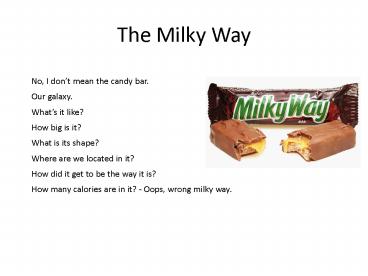The Milky Way PowerPoint PPT Presentation
1 / 37
Title: The Milky Way
1
The Milky Way
No, I dont mean the candy bar. Our
galaxy. Whats it like? How big is it? What is
its shape? Where are we located in it? How did it
get to be the way it is? How many calories are in
it? - Oops, wrong milky way.
2
The Milky Way Clue to its shape. What else?
Count the stars in various directions. Why?
3
Us - sun, whole solar system
Why doesnt it work? Too much stuff (dust, gas)
in the disk Impossible task?
4
Detour - back to stars Supergiants and Red Giants
In the Instability Strip
Instability Strip
Cepheids
What does this mean? They are unstable - They
pulsate! Two main types
RR Lyrae
5
Cepheids
High Mass Long periods Very Luminous (bright
giants - supergiants)
Cepheids are among the MOST important stars - Why?
6
1. Very bright 2. Period - Luminosity
Relation Time for pulsation period related to
actual brightness (Luminosity or Absolute
Magnitude)
You can use Cepheids to get distances to other
galaxies!
7
Determine their Periods
Find Cepheids
Use P-L relation ? the Absolute Magnitude Know
Absolute Magnitude ? Distance Easy!
8
RR Lyrae Stars
Similar to Cepheids, but Masses lt the
Sun Periods lt 1 day Luminosities - lower Only
for nearby distances How does this help us figure
out what the Milky Way is like? Ill get to
that.
9
Clusters
Two main types - Open Clusters and Globular
Clusters
Globular Cluster Characteristics 1,000,000
stars 25 pc wide - densely packed! Old, cool
stars Composition Low in metals Found away from
galactic disk Contain RR Lyrae
Open Clusters Few thousand stars 30 pc wide Hot,
young stars Composition Like Sun Found in
galactic disk Contain Cepheids
10
(No Transcript)
11
(No Transcript)
12
(No Transcript)
13
(No Transcript)
14
(No Transcript)
15
(No Transcript)
16
(No Transcript)
17
(No Transcript)
18
(No Transcript)
19
Back to the original question - How do we figure
out what the Milky Way is like? Harlow Shapley
Dont look in the disk of the galaxy - look
away from the disk look at the Globular
Clusters! What good will that do? Globular
Clusters contain RR Lyrae stars Get their
distances! Map out their location and you find..
Sun is no where near the center! Confirmed by
modern observations.
20
100,000 lightyears wide 30,000 pc (30 kiloparsecs)
Halo
Globular Clusters
Disk
Suns location 7500 pc out
Bulge
21
(No Transcript)
22
The Bulge
The center of the galaxy Contains the
core Sagittarius/Scorpius
23
(No Transcript)
24
Radio source in the center, Sgr A Object in the
exact center, Sgr A
25
Whats in the middle? Follow the motion of
objects around the Sgr A
Stars orbits the center Get P, a Keplers
law gives the mass as - 2.6 million solar
masses! What could it be?
26
The Disk
Many stars Gas and Dust Difficult to see
through Our galaxy has spiral arms, how many? Not
an easy question to answer. How do we answer it?
27
To find the location of the spiral arms, look for
regions of star formation Spiral Arm Tracers -
Things associated with large scale star
formation And the answer is. We dont know!
28
(No Transcript)
29
(No Transcript)
30
Disk Rotation
Main material in the disk - gas H I - neutral
hydrogen 21 cm (radio telescopes) What do we see?
Suns velocity 220 km/s 225 million years for 1
orbit Orbit? Can we use Keplers laws? Certainly!
31
Keplers Third law - Mgalaxy a3/p2
(Mgalaxy is actually mass within your
orbit) Suns orbit 100 billion M? Total mass
1 trillion M? Problem with the rotation not
decreasing
Dark Matter!
32
(No Transcript)
33
The Nude Jogger
Traffic moves to the right, jogger moving to left
Compression near jogger, but traffic keeps moving
Compression area moves along with jogger
34
What does this have to do with spiral arms?
Cars - material in galaxy Jogger - density
wave Region of compression - Spiral Arm Remember
- Spiral Pattern Moves Independently
35
Halo
Area away from the disk Globular clusters A lot
of dark matter Thats about all you can say about
the halo...
36
Stellar populations
Stars fuse light elements into heavier
elements Stars die and disperse elements out into
space Material in space can get incorporated into
new stars
End result - more metal rich stars over
time Metal anything other than Hydrogen and
Helium
37
Population II stars Not like the Sun Old, cool
stars Low metal content No active star formation
Population I stars Stars chemically like the
Sun Young, hot stars High metal
content Associated with active star formation

